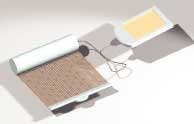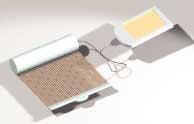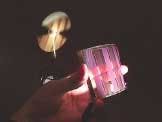By Ben Ames
TAUNTON, Mass. — The most rugged mobile computer is no use to a soldier if he runs out of electrical power in the field. Yet from laptops to radios to night vision goggles, modern troops rely on electronics more than ever.
A typical soldier carries five electronic devices and that number could rise to eight or nine over the next decade, say experts at Pacific Northwest National Laboratory in Richland, Wash. Modern warfighters must carry new technologies such as global positioning systems and hand-held chemical and biological-agent detectors.
Modern lithium-ion batteries can barely keep up with demand. Compared to shrinking microprocessors, they are heavy and short-lived. Even if he carried fresh batteries with him, a solider would blow his cover if he left a trail of spent cells everywhere he traveled.
Military electronics designers are looking at long-term solutions such as photovoltaic power, fuel cells, and power-conservation software. Researchers at the U.S. Army's Natick Soldier Center in Natick, Mass., are even working on a way to harness kinetic energy from boot heels to generate electricity each time a soldier's foot hits the ground.
None of those portable power sources are ready for the field yet, so troops today either must carry extra batteries in their packs or frequently plug their electronics into the diesel generator in the back of a High Mobile Multi-Wheeled Vehicle — best known as the HMMWV.
For designers of military electronics efficiency is now a top goal. "Power is the hard part," says Mike DiBiase, director of the commercial hardware systems division of General Dynamics C4 Systems in Taunton, Mass.
Most mobile military applications rely on rechargeable or expendable batteries, typically providing eight to ten hours of use, he says. Cost and weight add up fast if troops have to carry a supply of such batteries for any length of time.
Engineers at General Dynamics tweak the software in each device so it automatically keeps power draw to a minimum. They are also developing better ways to recharge batteries and are looking for new sources of electricity.
"We're looking at alternate power sources, including fuel cells," DiBiase says. The first devices running on fuel cell electricity could hit the market within one to three years. Fuel cells generate electricity from the chemical reaction between oxygen and a cartridge of fuel such as methanol or hydrogen. Commercial products today can recharge a cell phone or Palm-type hand-held computer but they do not scale up to heavier power demands.
Large computers such as servers and workstations are a bigger challenge. Soldiers in the field usually run them off a generator or off the battery in an idling vehicle. Both methods hinder battlefield stealth as engines produce noise and heat, and demand a constant fuel supply. General Dynamics engineers are trying to use large-scale fuel cells to replace generators. Such devices are still three to five years away from common use, DiBiase says.
Throughout the market, designers of portable military electronics agree that fuel-cell technology is not ready yet so they must rely on current batteries and design efficient electronics accordingly.
"Fuel cells are pretty cool, but there are no current implications, just future promise. I don't think we'll see anything in the market until the end of the decade," says Ed Fuhr, vice president of power solutions for Interpoint, a division of Crane Aerospace and Electronics, in Redmond, Wash.
Computer designers at Kontron face the same challenge. "We're taking a long, hard look at fuel cell, though the technology is not ready yet," says Greg Ackerman, program solutions manager at Kontron Mobile Computing Inc., Eden Prairie, Minn.
Fuel-cell technology will only mature once it finds applications in the commercial market, experts say.
"People will use it first for their cell phones, then PDAs, and then laptops," Ackerman says. The federal government's push for fuel-cell use in automobiles could also help drive the technology forward. Makers of laptop computers could bring their first fuel cell–driven computers to market by late 2004 or early 2005, he says.
For instance, engineers at Hitachi, the Japanese consumer electronics maker, have promised to launch cigarette lighter–sized fuel cells to power hand-held computers and personal digital assistants (PDAs) by 2005.
In the meantime, batteries are big business for military applications. In the seven weeks between April 1 and May 23 last year, one company alone — Electric Fuel Batteries, a subsidiary of Arotech Corp. in Auburn, Ala. — shipped 3,500 zinc-air batteries to U.S. forces in the Persian Gulf.
Electric Fuel Batteries officials tripled their company's manufacturing capacity to meet this demand, under contract to the U.S. Army's Communications-Electronics Command (CECOM) at Fort Monmouth, N.J.
The company sent the BA-8180 zinc-air battery, a 12/24-volt, 800-watt-hour, nonrechargeable battery pack about the size of a notebook computer, developed with funding from CECOM.
Zinc-air batteries are safer in combat and more environmentally friendly than lithium, company spokesmen say. These batteries also last longer than lithium; the BA-8180 provides four to six times the run time of a BA-5590, a primary lithium battery pack widely used in the military.
Overall, U.S. demand for batteries in military and aerospace applications should grow from $929.9 million in 2002 to $1,221.6 million by 2009, according to a report by consulting firm Frost and Sullivan in New York.
"The dynamic battery market for military equipment is offering vendors significant opportunities as research and development-oriented contracts are given by the government to continuously enhance existing battery chemistries," the report says.
Driving that growth is safety concerns with traditional military batteries such as lithium/thionyl chloride and lithium/sulfur dioxide, which can explode under rugged conditions. Those batteries also pose problems with their lifetimes and disposal, and restrict the mobility and endurance of troops in the field, the report says.
Researchers are developing technologies such as lithium/manganese dioxide and lithium ion. Rechargeable batteries with those chemistries offer lower cost and higher power density than current options.
For instance, the U.S. Department of Defense's Office of Naval Research is sponsoring projects to boost power density in batteries.
One company, Oak Ridge Micro-Energy Inc. of Oak Ridge, Tenn., completed a Phase One Small Business Innovative Research (SBIR) grant on this subject in July. The company developed new anode materials to get extra electricity from lithium-ion batteries. The new material is 30 percent more efficient for energy storage than traditional graphic carbon, a company spokesman says.
Researchers at Oak Ridge are also developing rechargeable thin-film power sources. Such batteries are thinner than common plastic wrap and appropriate for applications such as wireless sensors, radio frequency identification device (RFID) tags, chip memory backup, and security cards.
U.S. Army planners are also funding research into portable power generation, including one project that could produce self-powered uniforms and enclosures.
"One of the top concerns in the military is the need to develop ultra-lightweight renewable power for the equipment and electronics that soldiers use, such as displays, computer systems, and communications devices," says Philip Brandler, director of the Army Natick Soldier Center. "The weight of the batteries that soldiers must now carry is an ever-increasing problem, as the electronics behind future warrior systems become more sophisticated, complex, and reliant on portable battery power."
Current technologies fall short because disposable batteries littered across a battlefield can reveal soldiers' positions. Rechargeable batteries, meanwhile, need heavy equipment.
One Army-funded company has found a way to embed solar power converters in common plastic instead of fragile glass or silicon. Researchers at Konarka Technologies in Lowell, Mass., can make the shell of a typical laptop computer into a photovoltaic cell that can generate DC electric power from either indoor or outdoor light.
Using Konarka's proprietary manufacturing technique, researchers could even build self-powering enclosures, structures, and uniforms, the company claims.
"We supply power to remote locations; whether it's a footsoldier or ad hoc networks of sensor units, they all require battery power," says Russell Gaudiana, vice president of research and development at Konarka. "The fuel cell has the same problems as a battery: both run out. You have to add methanol to keep it going."
Photovoltaic fabrics would recharge batteries in the field, simply by sitting in the sun as part of soldiers' uniforms, tent covers, or camouflage gun covers. Konarka will offer its first products for sale by spring or summer 2005, he says. Konarka has also partnered with companies like ChevronTexaco and Eastman Chemical to apply this new technology to products in the commercial market.
Researchers at Battelle and Pacific Northwest National Lab (PNL) have been working for several years with the U.S. Army to develop small, lightweight power sources.
Last year, Pentagon planners accelerated that effort by expanding the program to include Army CECOM and the U.S. Marine Corps Expeditionary Program.
The plan could bear fruit as soon as March, when PNL researchers are due to unveil a portable, suitcase-sized fuel cell that produces 100 watts of power for recharging batteries or powering small electronics. The device will use methanol fuel, a Batelle-developed fuel processor, and a proton exchange membrane (known as PEM) fuel cell.
Over the next year, scientists will refine the technology and shrink the device to the size of a shoebox, says PNL Program Manager Chip Larson. And in the following year, they'll shrink it again to the size of a half-gallon container of ice cream and ruggedize it for field use.
The final version will be even smaller and able to use other hydrocarbon fuels such as butane, propane, and kerosene-based military JP-8.
Commercial researchers are developing similar systems. Scientists at Neah Power Systems in Bothell, Wash., have created an early prototype of a fuel cell that runs on methanol (a wood alcohol) and peroxide (a source of oxygen), says Greg Makuch, the company's director of marketing. In September, the company won a $2 million grant from the Advanced Technology Program at National Institute of Standards and Technology (NIST) in Gaithersburg, Md.
Potentially, the device will provide two or three times the run-time of conventional lithium-ion batteries, yet it will weigh half as much. "Lithium-ion technology is 10 to 15 years old, and is plateauing in terms of capacity improvement," Makuch says. "We envision a world where people will use lithium ion as their primary battery, then pop one of these in when needed."
Researchers must solve several problems first. One challenge is the by-products, which are water and carbon dioxide. Water vapor could short circuit a sealed electrical device, so designers must capture it and discard it later.
Another challenge is the efficiency. Basic fuel-cell design gives 25 to 30 percent efficiency, with the remainder lost to heat. If Neah researchers could boost that, they would get better gas mileage, smaller size, and reduced telltale heat signature.
A fuel cell mixes three items to create electricity: fuel, catalyst, and electrolyte. Researchers say that although hydrogen is the most efficient fuel, it is dangerous to transport and store, and generates too much heat for portable electronics. Their choice is methanol, which is stable, inexpensive, and renewable.
Another way to shrink the size of a fuel cell is to use oxygen from the atmosphere instead of peroxide canisters, but the oxygen concentration in hydrogen peroxide is 80 percent compared to just 20 percent in the air we breathe, Makuch says. Weather conditions like Iraqi sandstorms could reduce that even further.
Neah researchers plan to bring a product to market by 2005 or 2006. That first generation will run small, portable electronics, not power vehicles or create stationary backup power.
The company faces competition in the race to bring fuel cells to market. Traditional battery makers such as Toshiba, Casio, and NEC are all pursuing proton exchange membrane (PEM) designs, Makuch says. Neah's product is more efficient because it uses a silicon substrate to more efficiently mix the ingredients, he says.





